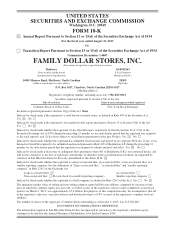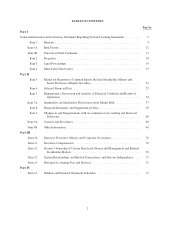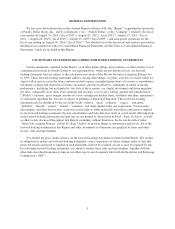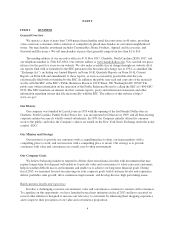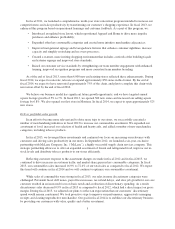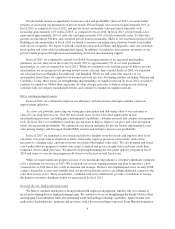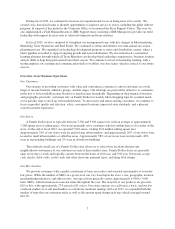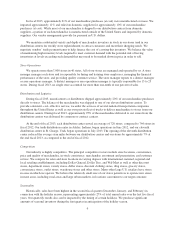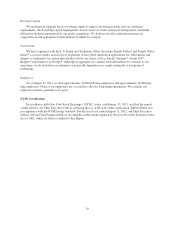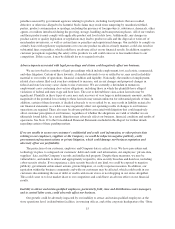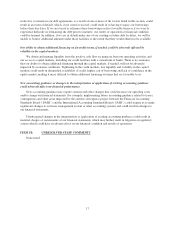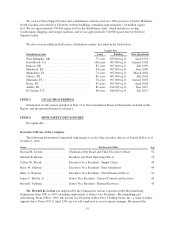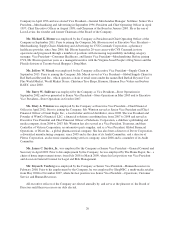Family Dollar 2013 Annual Report Download - page 15
Download and view the complete annual report
Please find page 15 of the 2013 Family Dollar annual report below. You can navigate through the pages in the report by either clicking on the pages listed below, or by using the keyword search tool below to find specific information within the annual report.
ITEM 1A. RISK FACTORS
The risks described below could materially and adversely affect our business, financial condition, results of
operations, cash flows, and capital investment and financing plans. We also may be adversely affected by risks
not currently known or risks that we do not currently consider to be material to our business.
Current economic conditions and other economic factors could adversely impact our business in various
respects, including impacting our customer’s disposable income or discretionary spending.
A further slowdown in the U.S. economy, delayed economic recovery or other economic factors affecting
disposable consumer income and discretionary spending, such as increased or sustained high unemployment or
underemployment levels, delays in tax refunds, inflation, business conditions, increased costs of essential
services including medical care and utilities, fuel and energy costs, consumer debt levels, lack of available credit,
and higher interest rates and tax rates may affect our business adversely by reducing overall consumer spending
and consumer discretionary spending. Changes in discretionary spending may cause customers to shift spending
to products other than those sold by us or change the mix of products we sell to products that are less profitable
and may result in slower inventory turnover and greater markdowns on inventory.
The current global economic uncertainty, the impact of recessions, the failure of Congress to approve
budgets in a timely manner, and the potential for failures or realignments of financial institutions and the related
impact on available credit may impact our suppliers, our landlords, and our operations in an adverse manner
including, but not limited to, our inability to readily access liquid funds or credit, increases in the cost of credit,
bankruptcy of our suppliers or landlords and other impacts, which we are currently unable to fully anticipate.
Our plans depend significantly on initiatives designed to increase sales and improve the efficiencies, costs and
effectiveness of our operations. Failure to achieve these plans could affect our performance adversely.
Higher costs or any failure to achieve targeted results associated with the implementation of new programs
or initiatives could adversely affect our results of operations. We are undertaking a variety of operating initiatives
and infrastructure initiatives including, but not limited to, significant merchandise expansions, a comprehensive
store renovation program, private brand expansion, and Global Sourcing initiatives. These changes may result in
temporary disruptions to our business and negatively impact sales. Additionally, the failure to properly execute
any of these initiatives or the failure to obtain the anticipated results of such initiatives could have an adverse
impact on our future operating results.
We operate in a highly competitive environment and, as a result, we may not be able to compete effectively or
maintain or increase our sales, market share or margins.
We operate in the highly competitive discount retail merchandise sector with numerous competitors, some
of which have greater resources than us. We compete for customers, merchandise, real estate locations, and
employees. This competitive environment subjects us to various risks, including the ability to continue our store
and sales growth and to provide attractive merchandise to our customers at competitive prices that allow us to
maintain our profitability. Price reductions by our competitors may result in the reduction of our prices and a
corresponding reduction in our profitability.
Consolidation in our retail sector, changes in pricing of merchandise or offerings of other services by
competitors could have a negative impact on the relative attractiveness of our stores to consumers. Many of our
large box competitors are or may be developing small box formats. A number of these smaller stores have
opened and may produce more competition, particularly in urban markets. Our ability to provide convenience in
a small box retail format while offering attractive, competitively-priced products could be impacted by various
actions of our competitors that are beyond our control. See Item 1—“Competition” for further discussion of our
competitive position.
11


